剑桥雅思9Test2雅思听力Section3答案解析
- 格式:doc
- 大小:21.50 KB
- 文档页数:3
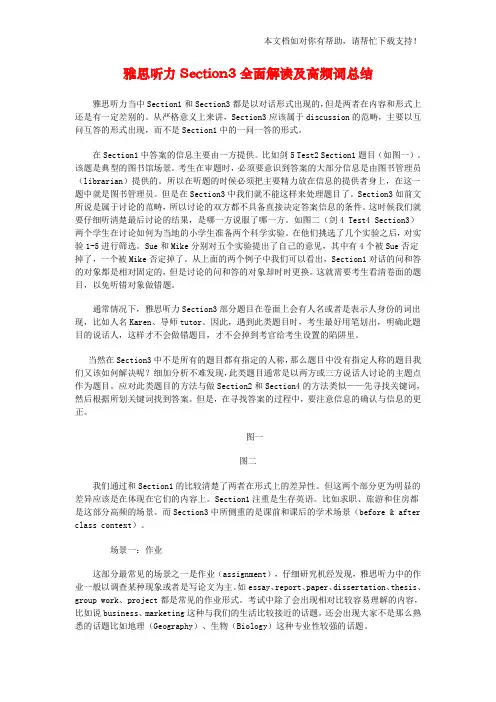
雅思听力Section3全面解读及高频词总结雅思听力当中Section1和Section3都是以对话形式出现的,但是两者在内容和形式上还是有一定差别的。
从严格意义上来讲,Section3应该属于discussion的范畴,主要以互问互答的形式出现,而不是Section1中的一问一答的形式。
在Section1中答案的信息主要由一方提供。
比如剑5 Test2 Section1题目(如图一)。
该题是典型的图书馆场景。
考生在审题时,必须要意识到答案的大部分信息是由图书管理员(librarian)提供的。
所以在听题的时候必须把主要精力放在信息的提供者身上,在这一题中就是图书管理员。
但是在Section3中我们就不能这样来处理题目了。
Section3如前文所说是属于讨论的范畴,所以讨论的双方都不具备直接决定答案信息的条件。
这时候我们就要仔细听清楚最后讨论的结果,是哪一方说服了哪一方。
如图二(剑4 Test4 Section3)两个学生在讨论如何为当地的小学生准备两个科学实验。
在他们挑选了几个实验之后,对实验1-5进行筛选。
Sue和Mike分别对五个实验提出了自己的意见,其中有4个被Sue否定掉了,一个被Mike否定掉了。
从上面的两个例子中我们可以看出,Section1对话的问和答的对象都是相对固定的,但是讨论的问和答的对象却时时更换。
这就需要考生看清卷面的题目,以免听错对象做错题。
通常情况下,雅思听力Section3部分题目在卷面上会有人名或者是表示人身份的词出现,比如人名Karen、导师tutor。
因此,遇到此类题目时,考生最好用笔划出,明确此题目的说话人,这样才不会做错题目,才不会掉到考官给考生设置的陷阱里。
当然在Section3中不是所有的题目都有指定的人称,那么题目中没有指定人称的题目我们又该如何解决呢?细加分析不难发现,此类题目通常是以两方或三方说话人讨论的主题点作为题目。
应对此类题目的方法与做Section2和Section4的方法类似——先寻找关键词,然后根据所划关键词找到答案。
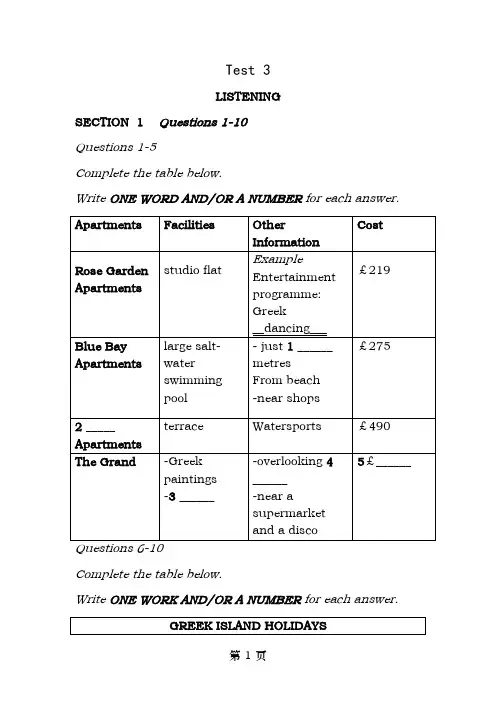
Test 3LISTENINGSECTION 1 Questions 1-10Questions 1-5Complete the table below.Write ONE WORD AND/OR A NUMBER for each answer.Complete the table below.Write ONE WORK AND/OR A NUMBER for each answer.Questions 11-13Choose the correct letter, A, B or C.Winridge Forest Railway Park11Simon’s idea for a theme park came fromA his childhood hobby.B his interest in landscape design.C his visit to another park.12 When they started, the family decided to open the park only whenA the weather was expected to be good.B the children weren’t at school.C there were fewer farming commitments.13 Since opening, the park has hadA 50,000 visitors.B 1,000,000 visitors.C 1,500,000 visitors.Questions 14-18What is currently the main area of work of each of the following people?Choose FIVE answers from the box and write the correct letter, A-H, next to questions 14-18.14 Simon (the speaker) _______15 Liz _______16 Sarah _______17 Duncan _______18 Judith _______Questions 19 and 20Complete the table below.Write ONE WORK AND/OR NUMBERS for each answer.Complete the notes below.Write NO MORE THAN TWO WORDS AND/OR A NUMBER for each answer.Study Skills Tutorial-Caroline Benning Dissertation topic: the 21______Strengths: ●22______● computer modeling Weaknesses: ● lack of background information● poor 23 ______ skills● Read all notes 29 ______Next tutorial date: 30 ______ JanuarySECTION 4 Questions 31-40Questions 31 and 32Choose the correct letter, A, B or C.31 The owners of the underground houseA had no experience of living in a rural area.B were interested in environmental issues.C wanted a professional project manager.32 What does the speaker say about the site of the house?A The land was quite cheap.B Stone was being extracted nearby.C It was in a completely unspoilt area.Questions 33-40Complete the notes below.Write ONE WORD AND/OR A NUMBER for each answer.READING PASSAGE 1You should spend about 20 minutes on Questions 1-13, which are based on Reading Passage 1 below.Attitudes to languageIt is not easy to be systematic and objective about language study. Popular linguistic debate regularly deteriorates into invective and polemic. Language belongs to everyone, so most people feel they have a right to hold an opinion about it. And when opinions differ, emotions can run high. Arguments can start as easily over minor points of usage as over major policies of linguistic education.Language, moreover, is a very public behaviour, so it is easy for different usages to be noted and criticized. No part of society or social behaviour is exempt: linguistic factorsinfluence how we judge personality, intelligence, social status, educational standards, job aptitude, and many other areas of identity and social survival. As a result, it is easy to hurt, and to be hurt, when language use is unfeelingly attacked.In its most general sense, prescriptivism is the view that one variety of language has an inherently higher value than others, and that this ought to be imposed on the whole of the speech community. The view is propounded especially in relation to grammar and vocabulary, and frequently with reference to pronunciation. The variety which is favoured, in this account, is usually a version of the ‘standard’ written language, especially as encountered in literature, or in the formal spoken language which most closely reflects this style. Adherents to this variety are said to speak orwr ite ‘correctly’; deviations from it are said to be‘incorrect’.All the main languages have been studied prescriptively, especially in the 18th century approach to the writing of grammars and dictionaries. The aims of these early grammarians were threefold: (a) they wanted to codify the principles of their languages, to show that there was a system beneath the apparent chaos of usage, (b) they wanted a means of settling disputes over usage, and (c) they wanted to point out what they felt to be common errors, in order to ‘improve’ the language. The authoritarian nature of the approach is best characterized by its reliance on‘rules’ of grammar. Some usages are ‘prescribed’, to be learnt and followed accurately; others are ‘proscribed’, to be avoided. In this early period, there were no half-measures: usage was either right or wrong, and it was thetask of the grammarian not simply to record alternatives, but to pronounce judgement upon them.These attitudes are still with us, and they motivate a widespread concern that linguistic standards should be maintained. Nevertheless, there is an alternative point of view that is concerned less with standards than with the facts of linguistic usage. This approach is summarized in the statement that it is the task of the grammarian to describe, not prescribe-to record the facts of linguistic diversity, and not to attempt the impossible tasks of evaluating language variation or halting language change. In the second half of the 18th century, we already find advocates of this view, such as Joseph Priestley, whose Rudiments of English Grammar(1761) insists that ‘the custom of speaking is the original and only just standard of any language’. Linguistic issue, it is argued, cannot be solved by logic and legislation. And this view has become the tenet of the modern linguistic approach to grammatical analysis.In our own time, the opposition between ‘descriptivists’ and ‘prescriptivists’ has often become extreme, with both sides painting unreal pictures of the other. Descriptive grammarians have been presented as people who do not care about standards, because of the way they see all forms of usage as equally valid. Prescriptive grammarians have been presented as blind adherents to a historical tradition. The opposition has even been presented in quasi-political terms — of radical liberalism vs elitist conservatism.Questions 1-8Do the following statements agree with the claims of the writer in Reading Passage 1?In boxes 1-8 on your answer sheet, writeYES if the statement agrees with the claims of the writerNO if the statement contradicts the claims of the writerNOT GIVEN if it is impossible to say what the writer thinks about this1 There are understandable reasons why arguments occur about language.2 People feel more strongly about language education thanabout small differences in language usage.3Our assessment of a person’s intelligence is affected by the way he or she uses language.4 Prescriptive grammar books cost a lot of money to buy in the 18th century.5 Prescriptivism still exists today.6 According to descriptivists it is pointless to try to stop language change.7 Descriptivism only appeared after the 18th century.8 Both descriptivists and prescriptivists have been misrepresented.Questions 9-12Complete the summary using the list of words, A-I, below. Write the correct letter, A-I, in boxes 9-12 on your answer sheet.The language debateAccording to 9______, there is only one correct form of language. Linguists who take this approach to language place great importance on grammatical 10 ______.Conversely, the view of 11 ______, such as Joseph Priestly, is that grammar should be based on 12 ______.Choose the correct letter, A, B, C or D.Write the correct letter in box 13 on your answer sheet.What is the writer’s purpose in Reading Passage 1?A.to argue in favour of a particular approach to writingdictionaries and grammar booksB.to present a historical account of differing views oflanguageC.to describe the differences between spoken and writtenlanguageD.to show how a certain view of language has beendiscreditedREADING PASSAGE 2You should spend about 20 minutes on Questions 14-26, which are based on Reading Passage 2 below.Tidal PowerUndersea turbines which produce electricity from the tides are set to become an important source of renewable energy for Britain. It is still too early to predict the extent of the impact they may have, but all the signs are that they will play a significant role in the futureA.Operating on the same principle as wind turbines, thepower in sea turbines comes from tidal currents whichturn blades similar to ships’ propellers, but, unlikewind, the tides are predictable and the power input isconstant. The technology raises the PROSPECT of Britain becoming self-sufficient in renewable energy anddrastically reducing its carbon dioxide emissions. If tide, wind and wave power are all developed, Britain would be able to close gas, coal and nuclear power plants andexport renewable power to other parts of Europe. Unlike wind power, which Britain originally developed and then abandoned for 20 years allowing the Dutch to make it a major industry, undersea turbines could become a bigexport earner to island nations such as Japan and New Zealand.B.Tidal sites have already been identified that will produceone sixth or more of the UK’s power-and at pricescompetitive with modern gas turbines and undercutting those of the already ailing nuclear industry. One sitealone, the Pentland Firth, between Orkney and mainland Scotland, could produce 10% of the country’s electricity with banks of turbines under the sea, and another atAlderney in the Channel Islands three times the 1,200megawatts of Britain’s largest and newe st nuclear plant, Sizewell B, in Suffolk. Other sites identified include theBristol Channel and the west coast of Scotland,particularly the channel between Campbeltown andNorthern Ireland.C.Work on designs for the new turbine blades and sites arewill ad vance at the University of Southampton’ssustainable energy research group. The first station isexpected to be installed off Lynmouth in Devon shortly to test the technology in a venture jointly funded by thedepartment of Trade and Industry and the EuropeanUnion. AbuBakr Bahaj, in charge of the Southamptonresearch, said: ‘The prospects for energy from tidalcurrents are far better than from wind because the flows of water are predictable and constant. The technology for dealing with the hostile saline environment under the sea has been developed in the North Sea oil industry andmuch is already known about turbine blade design,because of wind power and ship propellers. There are a few technical difficulties, but I believe in the next five to ten years we will be installing commercial marine turbine farms.’ Southampton has been awarded £215,000 over three years to develop the turbines and is working with Marine Current Turbines, a subsidiary of IT power, onthe Lynmouth project. EU research has now identified106 potential sites for tidal power, 80% round the coasts of Britain. The best sites are between islands or around heavily indented coasts where there are strong tidalcurrents.D. A marine turbine blade needs to be only one third of thesize of wind generator to produce three times as muchpower. The blades will be about 20 metres in diameter, so around 30 metres of water is required. Unlike windpower, there are unlikely to be environmental objections.Fish and other creatures are though unlikely to be atrisk from the relatively slow-turning blades. Each turbine will be mounted on a tower which will connect to thenational power supply grid via underwater cables. Thetowers will stick out of the water and be lit, to warnshipping, and also be designed to be lifted out of thewater for maintenance and to clean seaweed from theblades.E.Dr Bahaj has done most work on the Alderney site,where there are powerful currents. The single undersea turbine farm would produce far more power than needed for the Channel Islands and most would be fed into the French Grid and be re-imported into Britain via the cable under the Channel.F.One technical difficulty is cavitation, where low pressurebehind a turning blade causes air bubbles. These cancause vibration and damage the blades of the turbines.Dr Bahaj said: ‘We have to test a number of blade types to avoid this happening or at least make sure it does not damage the turbines or reduce performance. Anotherslight concern is submerged debris floating into theblades. So far we do not know how much of a problem it might be. We will have to make the turbines robustbecause the sea is a hostile environment, but all thesigns that we can do it are good.’Questions 14-17Reading Passage 2 has six paragraphs, A-F.Which paragraph contains the following information?Write the correct letter, A-F, in boxes 14-17 on your answer sheet.NB You may use any letter more than once.14 the location of the first test site15 a way of bringing the power produced on one site back into Britain16 a reference to a previous attempt by Britain to find analternative source of energy17 mention of the possibility of applying technology from another industryQuestions 18-22Choose FIVE letters, A-J.Write the correct letters in boxes 18-22 on your answer sheet.Which FIVE of the following claims about tidal power are made by the writer?Questions 23-26Label the diagram below.Choose NO MORE THAN TWO WORDS from the passage for each answer.Write your answers in boxes 23-26 on your answer sheet.An Undersea TurbineWhole tower can be raised for 23 ______ and the extraction of seaweed from the bladesSea life not in danger due to the fact that blades are comparatively 24 ______Air bubbles result from the 25 ______ behind blades. This is known as 26 ______READING PASSAGE 3You should spend about 20 minutes on Questions 27-40, which are based on Reading Passage 3 below.Information theory-the big ideaInformation theory lies at the heart of everything-from DVD players and the genetic code of DNA to the physics of the universe at its most fundamental. It has been central to the development of the science of communication, which enables data to be sent electronically and has therefore had a major impact on our livesA.In April 2002 an event took place which demonstratedone of the many applications of information theory. The space probe, Voyager I, Launched in 1997, had sent back spectacular images of Jupiter and Saturn and thensoared out of the Solar System on a one-way mission tothe stars. After 25 years of exposure to the freezingtemperatures of deep space, the probe was beginning to show its age. Sensors and circuits were on the brink of failing and NASA expers realized that they had to dosomething or lose contact with their probe forever. The solution was to get a message to Voyager I to instruct it to use spares to change the failing parts. With the probe12 billion kilometers from Earth, this was not an easytask. By means of a radio dish belonging to NASA’sDeep Space Network, the message was sent out into the depths of space. Even travelling at the speed of light, it took over 11 hours to reach its target, far beyond theorbit of Pluto. Yet, incredibly, the little probe managed to hear the faint call from its home planet, and successfully made the switchover.B.It was the longest-distance repair job in history, and atriumph for the NASA engineers. But it also highlighted the astonishing power of the techniqu4es developed by American communications engineer Claude Shannon,who had died just a year earlier. Born in 1916 inPetoskey, Michigan, Shannon showed an early talent for maths and for building gadgets, and madebreakthroughs in the foundations of computertechnology when still a student. While at BellLaboratories, Shannon developed information theory, but shunned the resulting acclaim. In the 1940s, he single-handedly created an entire science of communicationwhich has since inveigled its way into a host ofapplications, from DVDs to satellite communications to bar codes-any area, in short, where data has to beconveyed rapidly yet accurately.C.This all seems light years away from the down-to-earthuses Shannon originally had for his work, which began when he was a 22-year-old graduate engineering student at the prestigious Massachusetts Institute of Technology in 1939. He set out with an apparently simple aim: to pin down the precise meaning of the concept of‘information’. The most basic form of information,Shannon argued, is whether something is true of false —which can be captured in the binary unit, or ‘bit’, of the form 1 or 0. Having identified this fundamental unit, Shannon set about defining otherwise vague ideas about information and how to transmit it from place to place.In the process he discovered something surprising: it is always possible to guarantee information will get through random interference —‘noise’— intact.D.Noise usually means unwanted sounds which interferewith genuine information. Information theory generalizes this idea via theorems that capture the effects of noisewith mathematical precision. In particular, Shannonshowed that noise sets a limit on the rate at whichinformation can pass along communication channelswhile remaining error-free. This rate depends on therelative strengths of the signal and noise travelling down the communication channel, and on its capacity (its‘bandwidth’). The resulting limit, gi ven in units of bits per second, is the absolute maximum rate of error-free communication given singal strength and noise leve. The trick, Shannon showed, is to find ways of packaging up —‘coding’— information to cope with the ravages of noise, while staying within the information-carryingcapacity —‘bandwidth’— of the communicationsystem being used.E.Over the years scientists have devised many such codingmethods, and they have proved crucial in manytechnological feat. The Voyager spacecraft transmitteddata using codes which added one extra bit for everysingle bit of information; the result was an error rate of just one bit in 10,000-and stunningly clear pictures ofthe planets. Other codes have become part of everydaylife-such as the Universal Product Code, or bar code,which uses a simple error-detecting system that ensures supermarket check-out lasers can read the price even on, say, a crumpled bag of crisps. As recently as 1993,engineers made a major breakthrough by discovering so-called turbo codes-which come very close to Shannon’s ultimate limit for the maximum rate that data can betransmitted reliable, and now play a key role in themobile videophone revolution.F.Shannon also laid the foundations of more efficient waysof storing information, by stripping out superfluous(‘redundant’) bits from data which contributed littlereal information. As mobile phone text messages like ‘I CN C U’ show, it is often possible to leave out a lot ofdata without losing much meaning. As with errorcorrecting, h owever, there’s a limit beyond whichmessages become too ambiguous. Shannon showed how to calculate this limit, opening the way to the design ofcompression methods that cram maximum information into the minimum space.Questions 27-32Reading Passage 3 has six paragraphs, A-F.Which paragraph contains the following information?Write the correct letter, A-F, in boxes 27-32 on your answer sheet.27 an explanation of the factors affecting the transmission of information28 an example of how unnecessary information can be omitted29 a reference to Shannon’s attitude to fame30 details of a machine capable of interpreting incomplete information31 a detailed account of an incident involving information theory32 a reference to what Shannon initially intended to achieve in his researchQuestions 33-37Complete the notes below.Choose NO MORE THAN TWO WORDS form the passage for each answer.Write your answers in boxes 33-37 on your answer sheet.The Voyager 1 Space Probe●The probe transmitted pictures of both 33______ and______, then left the 34 ______.●The freezing temperatures were found to have a negativeeffect on parts of the space probe.●Scientists feared that both the 35 ______ and ______ wereabout to stop working.●The only hope was to tell the probe to replace them with36 ______ — but distance made communication with theprobe difficult.● A 37 ______ was used to transmit the message at thespeed of light.●The message was picked up by the probe and theswitchover took place.Questions 38-40Do the following statements agree with the information given in Reading PassGE 3?In boxes 38-40 on your answer sheet, writeTRUE if the statement agrees with the informationFALSE if the statement contradicts the informationNOT GIVEN if there is no information on this38 The concept of describing something as true or falsewas the starting point for Shannon in his attempts tosend message over distances.39 The amount of information that can be sent in a giventime period is determined with reference to the signalstrength and noise level.40 Products have now been developed which can conveymore information than Shannon had anticipated aspossible.WRITINGWRITING TASK1You should spend about 20 minutes on this task.WRITING TASK2You should spend about 40 minutes on this task.Write about the following topic:examples from your own knowledge or experience. Write at least 250 words.SPEAKINGPART 1The examiner asks the candidate about him/herself, his/her home, work or studies and other familiar topics. EXAMPLETelephoning●How often do you make telephone calls? [Why/Why not?]●Who do you spend most time talking to on thetelephone?[Why?]●When do you think you’ll next make a telephonecall?[Why?]●Do you sometimes prefer to send a text message insteadof telephoning? [Why/Why not?]PART 2the topic for one to two minutes.You have one minute to think about what you are going to say.You can make some notes to help you if you wish.PART 3Discussion topics:Reasons for daily travelExample questions:Why do people need to travel every day?What problems can people have when they are on their daily journey, for example to work or school? Why is this?Some people say that daily journeys like these will not be so common in the future. Do you agree or disagree? Why? Benefits of international travelExample questions:What do you think people can learn from travelling to other countries? Why?Can travel make a positive difference to the economy of a country? How?Do you think a society can benefit if its members have experience of travelling to other countries? In what ways?。
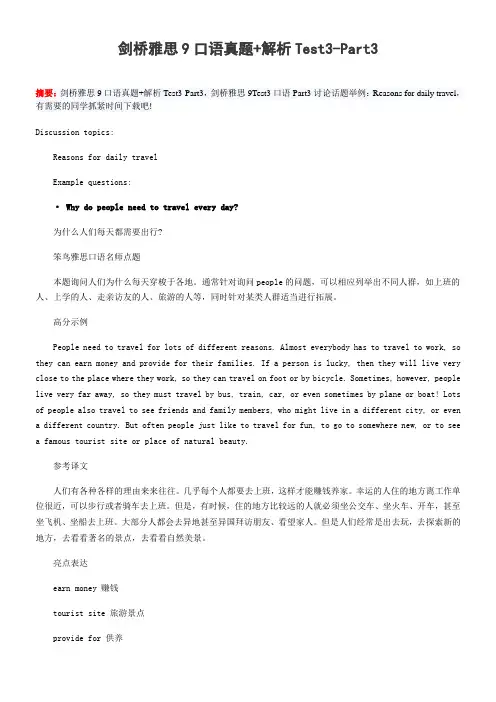
剑桥雅思9口语真题+解析Test3-Part3摘要:剑桥雅思9口语真题+解析Test3-Part3,剑桥雅思9Test3口语Part3讨论话题举例:Reasons for daily travel,有需要的同学抓紧时间下载吧!Discussion topics:Reasons for daily travelExample questions:· Why do people need to travel every day?为什么人们每天都需要出行?笨鸟雅思口语名师点题本题询问人们为什么每天穿梭于各地。
通常针对询问people的问题,可以相应列举出不同人群,如上班的人、上学的人、走亲访友的人、旅游的人等,同时针对某类人群适当进行拓展。
高分示例People need to travel for lots of different reasons. Almost everybody has to travel to work, so they can earn money and provide for their families. If a person is lucky, then they will live very close to the place where they work, so they can travel on foot or by bicycle. Sometimes, however, people live very far away, so they must travel by bus, train, car, or even sometimes by plane or boat! Lots of people also travel to see friends and family members, who might live in a different city, or even a different country. But often people just like to travel for fun, to go to somewhere new, or to see a famous tourist site or place of natural beauty.参考译文人们有各种各样的理由来来往往。
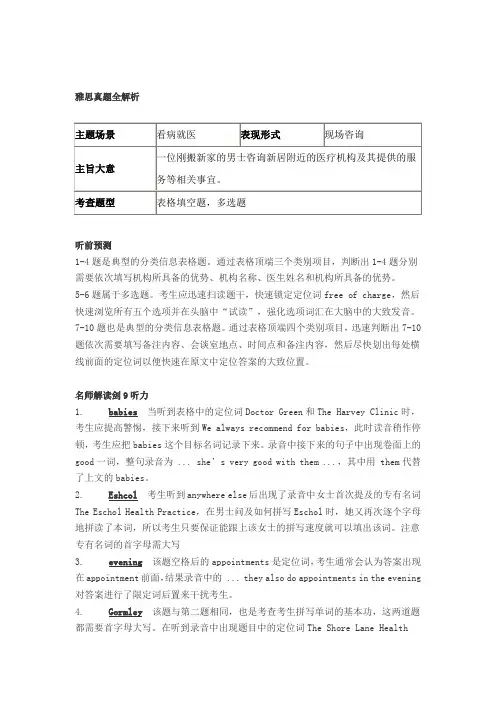
听前预测1-4题是典型的分类信息表格题。
通过表格顶端三个类别项目,判断出1-4题分别需要依次填写机构所具备的优势、机构名称、医生姓名和机构所具备的优势。
5-6题属于多选题。
考生应迅速扫读题干,快速锁定定位词free of charge,然后快速浏览所有五个选项并在头脑中“试读”,强化选项词汇在大脑中的大致发音。
7-10题也是典型的分类信息表格题。
通过表格顶端四个类别项目,迅速判断出7-10题依次需要填写备注内容、会谈室地点、时间点和备注内容,然后尽快划出每处横线前面的定位词以便快速在原文中定位答案的大致位置。
名师解读剑9听力1. babies当听到表格中的定位词Doctor Green和The Harvey Clinic时,考生应提高警惕,接下来听到We always recommend for babies,此时读音稍作停顿,考生应把babies这个目标名词记录下来。
录音中接下来的句子中出现卷面上的good一词,整句录音为 ... she’s very good with them ...,其中用 them代替了上文的babies。
2. Eshcol考生听到anywhere else后出现了录音中女士首次提及的专有名词The Eschol Health Practice,在男士问及如何拼写Eschol时,她又再次逐个字母地拼读了本词,所以考生只要保证能跟上该女士的拼写速度就可以填出该词。
注意专有名词的首字母需大写3. evening该题空格后的appointments是定位词,考生通常会认为答案出现在appointment前面,结果录音中的 ... they also do appointments in the evening 对答案进行了限定词后置来干扰考生。
4. Gormley该题与第二题相同,也是考查考生拼写单词的基本功,这两道题都需要首字母大写。
在听到录音中出现题目中的定位词The Shore Lane HealthCentre后就可以定位到医生的名字。
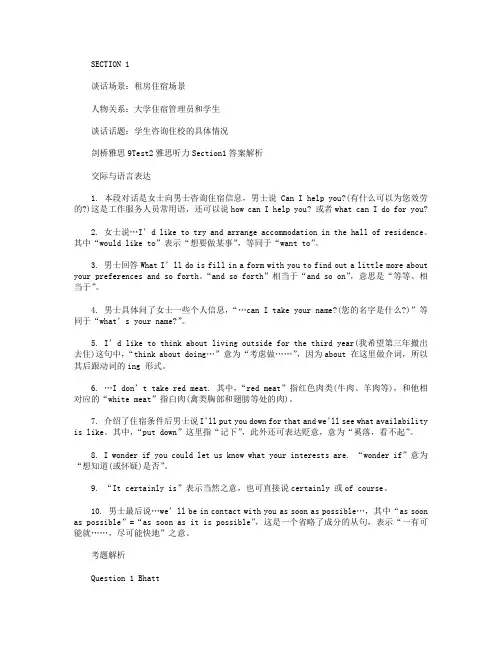
SECTION 1谈话场景:租房住宿场景人物关系:大学住宿管理员和学生谈话话题:学生咨询住校的具体情况剑桥雅思9Test2雅思听力Section1答案解析交际与语言表达1. 本段对话是女士向男士咨询住宿信息,男士说Can I help you?(有什么可以为您效劳的?)这是工作服务人员常用语,还可以说how can I help you? 或者what can I do for you?2. 女士说…I’d like to try and arrange accommodation in the hall of residence。
其中“would like to”表示“想要做某事”,等同于“want to”。
3. 男士回答What I’ll do is fill in a form with you to find out a little more about your preferences and so forth。
“and so forth”相当于“and so on”,意思是“等等、相当于”。
4. 男士具体问了女士一些个人信息,“…can I take your name?(您的名字是什么?)”等同于“what’s your name?”。
5. I’d like to think about living outside for the third year(我希望第三年搬出去住)这句中,“think about doing…”意为“考虑做……”,因为about 在这里做介词,所以其后跟动词的ing 形式。
6. …I don’t take red meat. 其中,“red meat”指红色肉类(牛肉、羊肉等),和他相对应的“white meat”指白肉(禽类胸部和翅膀等处的肉)。
7. 介绍了住宿条件后男士说I’ll put you down for that and we’ll see what availability is like。
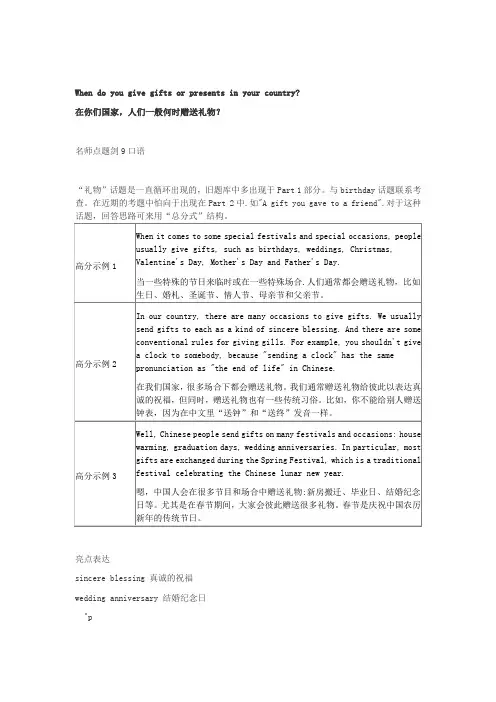
When do you give gifts or presents in your country?在你们国家,人们一般何时赠送礼物?名师点题剑9口语“礼物”话题是一直循环出现的,旧题库中多出现于Part 1部分。
与birthday话题联系考查。
在近期的考题中怕向于出现在Part 2中.如"A gift you gave to a friend".对于这种话题,回答思路可来用“总分式”结构。
高分示例1 When it comes to some special festivals and special occasions, people usually give gifts, such as birthdays, weddings, Christmas, Valentine's Day, Mother's Day and Father's Day.当一些特殊的节日来临时或在一些特殊场合.人们通常都会赠送礼物,比如生日、婚札、圣诞节、情人节、母亲节和父亲节。
高分示例2 In our country, there are many occasions to give gifts. We usually send gifts to each as a kind of sincere blessing. And there are some conventional rules for giving gills. For example, you shouldn't give a clock to somebody, because "sending a clock" has the same pronunciation as "the end of life" in Chinese.在我们国家,很多场合下都会赠送礼物。
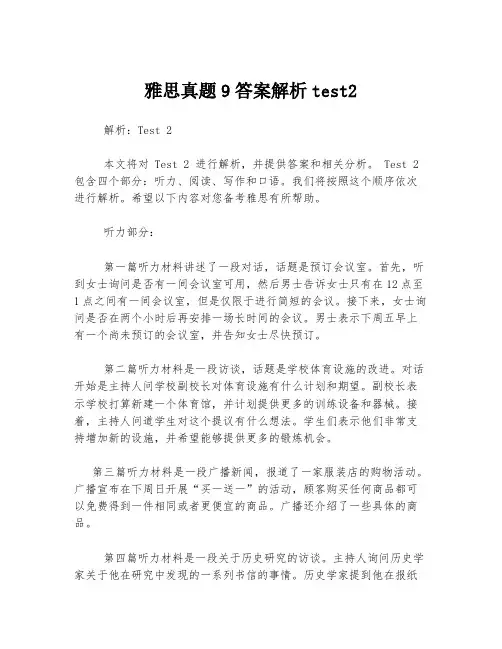
雅思真题9答案解析test2解析:Test 2本文将对 Test 2 进行解析,并提供答案和相关分析。
Test 2 包含四个部分:听力、阅读、写作和口语。
我们将按照这个顺序依次进行解析。
希望以下内容对您备考雅思有所帮助。
听力部分:第一篇听力材料讲述了一段对话,话题是预订会议室。
首先,听到女士询问是否有一间会议室可用,然后男士告诉女士只有在12点至1点之间有一间会议室,但是仅限于进行简短的会议。
接下来,女士询问是否在两个小时后再安排一场长时间的会议。
男士表示下周五早上有一个尚未预订的会议室,并告知女士尽快预订。
第二篇听力材料是一段访谈,话题是学校体育设施的改进。
对话开始是主持人问学校副校长对体育设施有什么计划和期望。
副校长表示学校打算新建一个体育馆,并计划提供更多的训练设备和器械。
接着,主持人问道学生对这个提议有什么想法。
学生们表示他们非常支持增加新的设施,并希望能够提供更多的锻炼机会。
第三篇听力材料是一段广播新闻,报道了一家服装店的购物活动。
广播宣布在下周日开展“买一送一”的活动,顾客购买任何商品都可以免费得到一件相同或者更便宜的商品。
广播还介绍了一些具体的商品。
第四篇听力材料是一段关于历史研究的访谈。
主持人询问历史学家关于他在研究中发现的一系列书信的事情。
历史学家提到他在报纸上看到一则拍卖消息,其中包括一封希特勒写给他姐姐的信。
随后,他联系了卖家并成功购买了这些信件。
这些信件给我们提供了对希特勒生活和思想的更多了解。
阅读部分:第一篇阅读文章是一则关于夏威夷群岛的自然保护与旅游的文章。
文章介绍了夏威夷的自然景观和植物动物保护项目,并提到了旅游业对于夏威夷经济和环境保护的重要性。
文章中还提到一些导致夏威夷环境问题的因素,并探讨了如何在旅游业和环境保护之间取得平衡。
第二篇阅读文章是一篇关于深海生物的科学研究文章。
文章介绍了科学家对深海生物的研究成果,包括新发现的物种、生态系统和环境适应性。
文章中提到了深海生物的生存环境以及科学家对其研究的挑战。
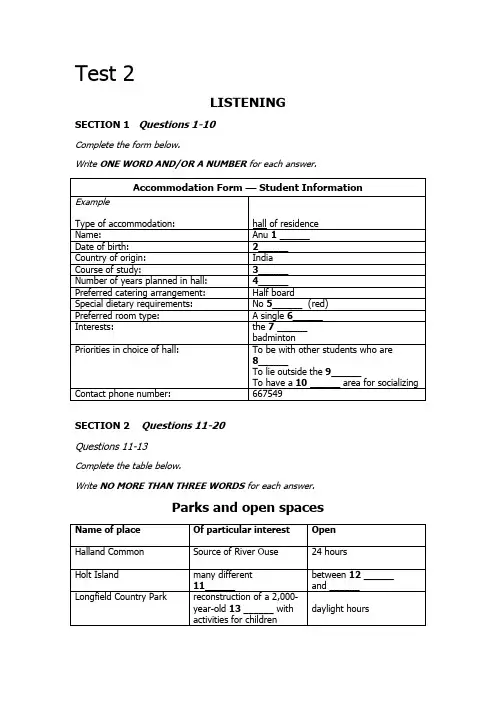
Test 2LISTENING SECTION 1 Questions 1-10Complete the form below.Write ONE WORD AND/OR A NUMBER for each answer.SECTION 2 Questions 11-20Questions 11-13Complete the table below.Write NO MORE THAN THREE WORDS for each answer.Parks and open spacesQuestions 14-16Choose the correct letter, A, B or C.Longfield Park14As part of Monday’s activity, visitors willA prepare food with herbs.B meet a well-known herbalist.C dye cloth with herbs.15 For the activity on Wednesday,A only group bookings are accepted.B visitors should book in advance.C attendance is free.16 For the activity on Saturday, visitors shouldA come in suitable clothing.B make sure they are able to stay for the whole day.C tell the rangers before the event what they wish to do. Questions 17-20Label the map below.Write the correct letter, A-I, next to questions 17-20.Hinchingbrooke Park17 bird hide ______18 dog-walking area ______19 flower garden ______20 wooded area ______SECTION 3 Questions 21-30Questions 21-24Choose the correct letter, A, B or C.Self-Access Centre21 Students want to keep the Self-Access Centre becauseA they enjoy the variety of equipment.B they like being able to work on their own.C it is important part of their studies.22 Some teachers would prefer toA close the Self-Access Centre.B move the Self-Access Centre elsewhere.C restrict access to the Self-Access Centre.23The students’ main concern about using the library would beA the size of the library.B difficulty in getting help.C the lack of materials.24 The Director of Studies is concerned aboutA the cost of upgrading the centre.B the lack of space in the centre.C the difficulty in supervising the centre.Questions 25-30Complete the notes below.Write NO MORE THAN WORDS for each answer.SECTION 4 Questions 31-40 Complete the notes below.Write ONE WORD ONLY for each answer.READINGREADING PASSAGE 1You should spend about 20 minutes on Questions 1-13, which are based on Reading Passage 1 below.A.Hearing impairment or other auditory function deficit in young children can havea major impact on their development of speech and communication, resulting ina detrimental effect on their ability to learn at school. This is likely to have majorconsequences for the individual and the population as a whole. The NewZealand Ministry of Health has found from research carried out over two decades that 6-10% of children in that country are affected by hearing loss.B. A preliminary study in New Zealand has shown that classroom noise presents amajor concern for teachers and pupils. Modern teaching practices, theorganization of desks in the classroom, poor classroom acoustics, andmechanical means of ventilation such as air-conditioning units all contribute to the number of children unable to comprehend the teacher’s voice. Educationresearchers Nelson and Soli have also suggested that recent trends in learning often involve collaborative interaction of multiple minds and tools as much as individual possession of information. This all amounts to heightened activity and noise levels, which have the potential to be particularly serious for childrenexperiencing auditory function deficit. Noise in classrooms can only exacerbate their difficulty in comprehending and processing verbal communication withother children and instructions from the teacher.C.Children with auditory function deficit are potentially failing to learn to theirmaximum potential because of noise levels generated in classrooms. The effects of noise on the ability of children to learn effectively in typical classroomenvironments are now the subject of increasing concern. The InternationalInstitute of Noise Control Engineering (I-INCE), on the advice of the WorldHealth Organization, has established an international working party, whichincludes New Zealand, to evaluate noise and reverberation control for schoolrooms.D.While the detrimental effects of noise in classroom situations are not limited tochildren experiencing disability, those with a disability that affects theirprocessing of speech and verbal communication could be extremely vulnerable.The auditory function deficits in question include hearing impairment, autistic spectrum disorders (ASD) and attention deficit disorders (ADD/ADHD).E.Autism is considered a neurological and genetic life-long disorder that causesdiscrepancies in the way information is processed. This disorder is characterized by interlinking problems with social imagination, social communication and social interaction. According to Janzen, this affects the ability to understand and relate in typical ways to people, understand events and objects in the environment, and understand or respond to sensory stimuli. Autism does not allow learning or thinking in the same ways as in children who are developing normally. Autistic spectrum disorders often result in major difficulties in comprehending verbalinformation and speech processing. Those experiencing these disorders often find sounds such as crowd noise and the noise generated by machinery painful and distressing. This is difficult to scientifically quantify as such extra-sensory stimuli vary greatly from one autistic individual to another. But a child who finds any type of noise in their classroom or learning space intrusive is likely to beadversely affected in their ability to process information.F.The attention deficit disorders are indicative of neurological and geneticdisorders and are characterized by difficulties with sustaining attention, effort and persistence, organization skills and disinhibition. Children experiencing these disorders find it difficult to screen out unimportant information, and focus on everything in the environment rather than attending to a single activity.Background noise in the classroom becomes a major distraction, which canaffect their ability to concentrate.G.Children experiencing an auditory function deficit can often find speech andcommunication very difficult to isolate and process when set against high levels of background noise. These levels come from outside activities that penetrate the classroom structure, from teaching activities, and other noise generatedinside, which can be exacerbated by room reverberation. Strategies are needed to obtain the optimum classroom construction and perhaps a change inclassroom culture and methods of teaching. In particular, the effects of noisy classrooms and activities on those experiencing disabilities in the form ofauditory function deficit need thorough investigation. It is probable that many undiagnosed children exist in the education system with ‘invisible’ disabilities.Their needs are less likely to be met than those of children with knowndisabilities.H.The New Zealand Government has developed a New Zealand Disability Strategyand has embarked on a wide-ranging consultation process. The strategyrecognizes that people experiencing disability face significant barriers inachieving a full quality of life in areas such as attitude, education, employment and access to service. Objective 3 of the New Zealand Disability Strategy is to ‘Provide the Best Education for Disabled People’ by improving education so that all children, youth learners and adult learners will have equal opportunities to learn and develop within their already existing local school. For a successfuleducation, the learning environment is vitally significant, so any effort toimprove this is likely to be of great benefit to all children, but especially to those with auditory function disabilities.I. A number of countries are already in the process of formulating their ownstandards for the control and reduction of classroom noise. New Zealand willprobably follow their example. The literature to date on noise in school rooms appears to focus on the effects on schoolchildren in general, their teachers and the hearing impaired. Only limited attention appears to have been given to thosestudents experiencing the other disabilities involving auditory function deficit. It is imperative that the needs of these children are taken into account in thesetting of appropriate international standards to be promulgated in future. Questions 1-6Reading Passage 1 has nine sections, A-I.Which section contains the following information?Write the correct letter, A-I, in boxes 1-6 on your answer sheet.1 an account of a national policy initiative2 a description of a global team effort3 a hypothesis as to one reason behind the growth in classroom noise4 a demand for suitable worldwide regulations5 a list of medical conditions which place some children more at risk from noisethan others6 the estimated proportion of children in New Zealand with auditory problems Questions 7-10Answer the questions below.Choose NO MORE THAN TWO WORDS AND/OR A NUMBER from the passage for each answer.Write your answers in boxes 7-10 on your answer sheet.7 For what period of time has hearing loss in schoolchildren been studied in NewZealand?8 In addition to machinery noise, what other type of noise can upset children withautism?9 What term is used to describe the hearing problems of schoolchildren whichhave not been diagnosed?10 What part of the New Zealand Disability Strategy aims to give schoolchildrenequal opportunity?Questions 11 and 12Choose TWO letters, A-F.Write the correct letters in boxes 11 and 12 on your answer sheet.The list below includes factors contributing to classroom noise.Which TWO are mentioned by the writer of the passage?A current teaching methodsB echoing corridorsC cooling systemsD large class sizesE loud-voiced teachersF playground gamesQuestion 13Choose the correct letter, A, B, C or D.Write the correct letter in box 13 on your answer sheet.What is the writer’s overall purpose in writing this article?A to compare different methods of dealing with auditory problemsB to provide solutions for overly noisy learning environmentsC to increase awareness of the situation of children with auditory problemsD to promote New Zealand as a model for other countries to followREADING PASSAGE 2You should spend about 20 minutes on Questions 14-26, which are based on Reading Passage 2 below.Venus in transitJune 2004 saw the first passage, known as a ‘transit’, of the planet Venus across the face of the sun in 122 years. Transits have helped shape our view of the whole Universe, as Heather Cooper and Nigel Henbest explainA.On 8 June 2004, more than half the population of the world were treated to arare astronomical event. For over six hours, the planet Venus steadily inched its way over the surface of the Sun. This ‘transit’ of Venus was the first since 6December 1882. On that occasion, the American astronomer Professor Simon Newcomb led a party to South Africa to observe the event. They were based at girls’ school, where— it is alleged — the combined forces of threeschoolmistresses outperformed the professionals with the accuracy of theirobservations.B.For centuries, transits of Venus have drawn explorers and astronomers alike tothe four corners of the globe. And you can put it all down to the extraordinary polymath Edmond Halley. In November 1677, Halley observed a transit of the innermost planet, Mercury, from the desolate island of St Helena in the South Pacific. He realized that, from different latitudes, the passage of the planetacross the Sun’s disc would appear to differ. By timing the transit from twowidely-separated locations, teams of astronomers could calculate the parallax angle — the apparent difference in position of an astronomical body due to a difference in the observer’s position. Calculating this angle would allowastronomers to measure what was then the ultimate goal: the distance of the Earth from the Sun. This distance is known as the ‘astronomical unit’ or AU.C.Halley was aware that the AU was one of the most fundamental of allastronomical measurements. Johannes Kepler, in the early 17th century, hadshown that the distances of the planets from the Sun governed their orbitalspeeds, which were easily measurable. But no-one had found a way to calculate accurate distances to the planets from the Earth. The goal was to measure the AU; then, knowing the orbital speeds of all the other planets round the Sun, the scale of the Solar System would fall into place. However, Halley realized thatMercury was so far away that its parallax angle would be very difficult todetermine. As Venus was closer to the Earth, its parallax angle would be larger, and Halley worked out that by using Venus it would be possible to measure the Sun’s distanc e to 1 part in 500. But there was a problem: transits of Venus,unlike those of Mercury, are rare, occurring in pairs roughly eight years apartevery hundred or so years. Nevertheless, he accurately predicted that Venuswould cross the fact of the Sun in both 1761 and 1769 —though he didn’tsurvive to see either.D.Inspired by Halley’s suggestion of a way to pin down the scale of the SolarSystem, teams of British and French astronomers set out on expeditions toplaces as diverse as India and Siberia. But th ings weren’t helped by Britain and France being at war. The person who deserves most sympathy is the Frechastronomer Guillaume Le Gentil. He was thwarted by the fact that the Britishwere besieging his observation site at Pondicherry in India. Fleeing on a French warship crossing the Indian Ocean, Le Gentil saw a wonderful transit — but the ship’s pitching and rolling ruled out any attempt at making accurate observations.Undaunted, he remained south of the equator, keeping himself busy by studying the islands of Maurtius and Madagascar before setting off to observe the next transit in the Philippines. Ironically after travelling nearly 50,000 kilometres, his view was clouded out at the last moment, a very dispirting experience.E.While the early transit timings were as precise as instruments would allow, themeasurements were dogged by the ‘black drop’ effect. When Venus begins to cross the Sun’s disc, it looks smeared not circular-which makes it difficult toestablish timings. This is due to diffraction of light. The second problem is that Venus exhibits a halo of light when it is seen just outside the sun’s disc. While this showed astronomers that Venus was surrounded by a thick layer of gases refracting sunlight around it, both effects made it impossible to obtain accurate timings.F.But astronomers laboured hard to analyse the results of these expeditions toobserve Venus transits. Johann Franz Encke, Director of the Berlin Observatory,finally determined a value for the AU based on all these parallax measurements: 153,340,000 km. Reasonably accurate for the time, that is quite close to today’s value of 149,597,870 km, determined by radar, which has now supersededtransits and all other methods in accuracy. The AU is a cosmic measuring rod, and the basis of how we scale the Universe today. The parallax principle can be extended to measure the distances to the stars. If we look at a star in January-when Earth is at one point in its orbit-it will seem to be in a different position from where it appears six months late. Knowing the width of Earth’s orbit, the parallax shift lets astronomers calculate the distance.G.June 2004’s transit of Venus was thus more of an astronomical spectacle than ascientifically important event. But such transits have paved the way for what might prove to be one of the most vital breakthroughs in the cosmos-detecting Earth-sized planets orbiting other stars.Questions 14-17Reading Passage 2 has seven paragraphs, A-G.Which paragraph contains the following information?Write the correct letter, A-G, in boxes 14-17 on your answer sheet.14 examples of different ways in which the parallax principle has been applied15 a description of an event which prevented a transit observation16 a statement about potential future discoveries leading on from transitobservations17 a description of physical states connected with Venus which early astronomicalinstruments failed to overcomeQuestions 18-21Look at the following statements (Questions 18-21) and the list of people below. Match each statement with the correct person, A, B, C or D.Write the correct letter, A, B, C or D, in boxes 18-21 on your answer sheet.18 He calculated the distance of the sun from the Earth based on observations ofVenus with a fair degree of accuracy.19 He understood that the distance of the Sun from the Earth could be worked outby comparing obsevations of a transit.20 He realize that the time taken by a planet to go round the Sun depends on itsdistance from the Sun.21 He witnessed a Venus transit but was unable to make any calculations.Question 22-26Do the following statements agree with the information given in Reading Passage 2? In boxes 22-26 on your answer sheet, writeTRUE if the statement agrees with the informationFALSE if the statement contradicts the informationNOT GIVEN if there is no information on this22 Halley observed one transit of the planet Venus.23 Le Gentil managed to observe a second Venus transit.24 The shape of Venus appears distorted when it starts to pass in front of the Sun.25 Early astronomers suspected that the atmosphere on Venus was toxic.26 The parallax principle allows astronomers to work out how far away distantstars are from the Earth.READING PASSAGE 3You should spend about 20 minutes on Questions 27-40, which are based on Reading Passage 3 below.A neuroscientist revealshow to think differentlyIn the last decade a revolution has occurred in the way that scientists think about the brain. We now know that the decisions humans make can be traced to the firing patterns of neurons is specific part of the brain. These discoveries have led to the field know as neuroeconomics, which studies the brain’s secrets to success in an economic environment that demands innovation and being able to do things differently from competitors. A brain that can do this is an iconoclastic one. Briefly, an iconoclast is a person who does so mething that others say can’t be done.This definition implies that iconoclasts are different from other people, but more precisely, it is their brains that are different in three distinct ways: perception, fear response, and social intelligence. Each of these three functions utilizes a different circuit in the brain. Naysayers might suggest that the brain is irrelevant, that thinking in an original, even revolutionary, way is more a matter of personality than brain function. But the field of neuroeconomics was born out of the realization that the physical workings of the brain place limitations on the way we make decisions. Byunderstanding these constraints, we begin to understand why some people march to a different drumbeat.The first thing to realize is that the brain suffers from limited resources. It has a fixed energy budget, about the same as a 40 watt light bulb, so it has evolved to work as efficiently as possible. This is where most people are impeded from being an iconoclast. For example, when confronted with information streaming from the eyes, the brain will interpret this information in the quickest way possible. Thus it will draw on both past experience and any other source of information, such as what other people say, to make sense of what it is seeing. This happens all the time. The brain takes shortcuts that work so well we are hardly ever aware of them. We think our perceptions of the world are real, but they are only biological and electrical rumblings. Perception is not simply a product of what your eyes or ears transmit to your brain. More than the physical reality of photons or sound waves, perception is product of the brain.Perception is central to iconoclasm. Iconoclasts see things differently to other people. Their brains do not fal l into efficiency pitfalls as much as the average person’s brain. Iconoclasts, either because they were born that way or through learning, have found ways to work around the perceptual shortcuts that plague most people. Perception is not something that is hardwired into the brain. It is a learned process, which is both a curse and an opportunity for change. The brain faces the fundamental problem of interpreting physical stimuli from the senses. Everything the brain sees, hears, or touches has multiple interpretations. The one that is ultimately chosen is simply the brain’s best theory. In technical terms, these conjectures have their basis in the statistical likelihood of one interpretation over another and are heavily influenced by past experience and, importantly for potential iconoclasts, what other people say. The best way to see things differently to other people is to bombard the brain with things it has never encountered before. Novelty releases the perceptual process from the chains of past experience and forces the brain to make new judgments. Successful iconoclasts have an extraordinary willingness to be exposed to what is fresh and different. Observation of iconoclasts shows that they embrace novelty while mot people avoid things that are different.The problem with novelty, however, is that it tends to trigger the brain’s fear system. Fear is a major impediment to thinking like an iconoclast and stops the average person in his tracks. There are many types of fear, but the two that inhibit iconoclastic thinking and people generally find difficult to deal with are fear of uncertainty and fear of public ridicule. These may seem like trivial phobias. But fear of public speaking, which everyone must do from time to time, afficts one-thirds of the population. This makes it too common to be considered a mental disorder. It is simply a common variant of human nature, one which iconoclasts do not let inhibit their reactions.Finally, to be successful iconoclasts, individuals must sell their ideas to other people. This is where social intelligence comes in. Social intelligence is the ability to understand and manage people in a business setting. In the last decade there has been an explosion of knowledge about the social brain and how the brain works when groups coordinate decision making. Neuroscience has revealed which brain circuits are responsible for functions like understanding what other people think, empathy, fairness, and social identity. These brain regions play key roles in whether people convince others of their ideas. Perception is important in social cognition too.The perception of someone’s enthusiasm, or reputation, can make or break a deal. Understanding how perception becomes intertwined with social decision making shows why successful iconoclast are so rare.Iconoclasts create new opportunities in every area from artistic expression to technology to business. They supply creativity and innovation not easily accomplished by committees. Rules aren’t important to them. Iconoclasts face alienation and failure, but can also be a major asset to any organization. It is crucial for success in any field to understand how the iconoclastic mind works. Questions 27-31Choose the correct letter, A, B, C or D.Write the correct letter in boxes 27-31 on your answer sheet.27 Neuroeconomics is a field of study which seeks toA cause a change in how scientists understand brain chemistry.B understand how good decisions are made in the brain.C understand how the brain is linked to achievement in competitive fields.D trace the specific firing patterns of neurons in different areas of the brain.28 According to the writer, iconoclasts are distinctive becauseA they create unusual brain circuits.B their brains function differently.C their personalities are distinctive.D they make decisions easily.29 According to the writer, the brain works efficiently becauseA it uses the eyes quickly.B it interprets data logically.C it generates its own energy.D it relies on previous events.30 The writer says that perception isA a combination of photons and sound waves.B a reliable product of what your senses transmit.C a result of brain processes.D a process we are usually conscious of.31 According to the writer, an iconoclastic thinkerA centralizes perceptual thinking in one part of the brain.B avoids cognitive traps.C has a brain that is hardwired for learning.D has more opportunities than the average person.Questions 32-37Do the following statements agree with the claims of the writer in Reading Passage 3? In boxes 32-37 on your answer sheet, writeYES if the statement agrees with the claims of the writerNO if the statement contradicts the claims of the writerNOT GIVEN if it is impossible to say what the writer thinks about this32 Exposure to different33 Iconoclasts are unusually receptive to new experiences.34 Most people are too shy to try different things.35 If you think in an iconoclastic way, you can easily overcome fear.36 When concern about embarrassment matters less, other fears become irrelevant.37 Fear of public speaking is a psychological illness.Questions 38-40Complete each sentence with the correct ending, A-E, below.Write the correct letter, A-E, in boxes 38-40 on your answer sheet.38 Thinking like a successful iconoclast is demanding because it39 The concept of the social brain is useful to iconoclasts because it40 Iconoclasts are generally an asset because their way of thinkingWRITINGWRITING TASK 1You should spend about 20 minutes on this task.Write at least 150 words.UK telephone calls, by category, 1995-2002Call type:Local-fixed lineNational and international-fixed lineMobiles (all calls)WRITING TASK 2You should spend about 40 minutes on this task.Write about the following topic.Give reasons for your answer and include any relevant examples from your own knowledge or experience.Write at least 250 words.SPEAKINGPART 1The examiner asks the candidate about him/herself, his/her home, work or studies and other familiar topics.EXAMPLEGiving gifts●When do people given gifts or presents in your country?●Do you ever take a gift when you visit someone in their home? [Why/Why not?] ●When did you last receive a gift? [What was it?]●Do you enjoy looking for gifts for people? [Why/Why not?]PART 2You will have to talk about the topic forone to two minutes.You have one minute to think aboutwhat you are going to say.You can make some notes to help you ifyou wish.PART 3Discussion topics:Doing new thingsExample questions:Why do you think some people like doing new things?What problems can people have when they try new activities for the first time?Do you think it’s best to do new things on your own or with other people? Why? Learning new thingsExample questions:What kinds of things do children learn to do when they are very young? How important are these things?Do you think children and adults learn to do new things in the same way? How is their learning style different?Some people say that it is more important to be able to learn new things now than it was in the past. Do you agree or disagree with that? Why?。
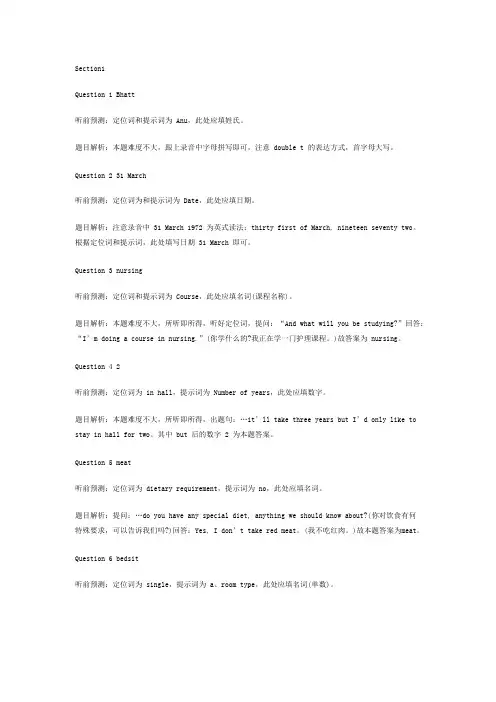
Section1Question 1 Bhatt听前预测:定位词和提示词为 Anu,此处应填姓氏。
题目解析:本题难度不大,跟上录音中字母拼写即可,注意 double t 的表达方式,首字母大写。
Question 2 31 March听前预测:定位词为和提示词为 Date,此处应填日期。
题目解析:注意录音中 31 March 1972 为英式读法:thirty first of March, nineteen seventy two。
根据定位词和提示词,此处填写日期 31 March 即可。
Question 3 nursing听前预测:定位词和提示词为 Course,此处应填名词(课程名称)。
题目解析:本题难度不大,所听即所得,听好定位词,提问:“And what will you be studying?”回答:“I’m doing a course in nursing.”(你学什么的?我正在学一门护理课程。
)故答案为 nursing。
Question 4 2听前预测:定位词为 in hall,提示词为 Number of years,此处应填数字。
题目解析:本题难度不大,所听即所得,出题句:…it’ll take three years but I’d only like to stay in hall for two。
其中 but 后的数字 2 为本题答案。
Question 5 meat听前预测:定位词为 dietary requirement,提示词为 no,此处应填名词。
题目解析:提问:…do you have any special diet, anything we should know about?(你对饮食有何特殊要求,可以告诉我们吗?)回答:Yes, I don’t take red meat。
(我不吃红肉。
)故本题答案为meat。
Question 6 bedsit听前预测:定位词为 single,提示词为 a、room type,此处应填名词(单数)。
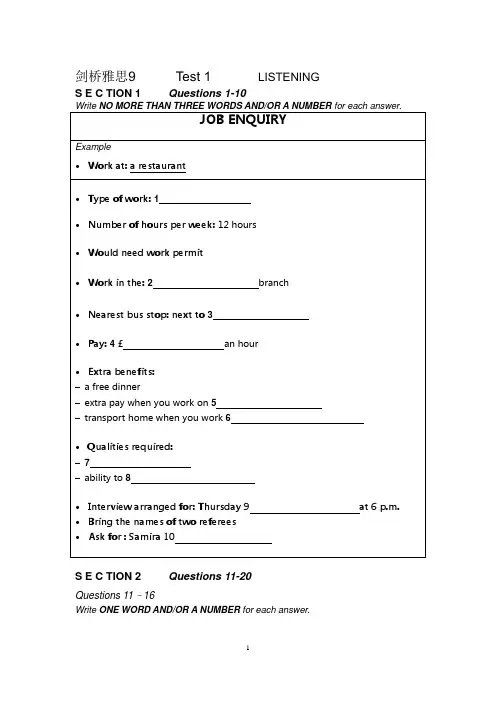
剑桥雅思9 Test 1 LISTENINGS E C TION 1 Questions 1-10Write NO MORE THAN THREE WORDS AND/OR A NUMBER for each answer.JOB ENQUIRYExample·Work at: a restaurant·Type of work: 1·Number of hours per week: 12 hours·Would need work permit·Work in the: 2 branch·Nearest bus stop: next to 3·Pay: 4£an hour·Extra benefits:–a free dinner–extra pay when you work on 5–transport home when you work 6·Qualities required:–7–ability to 8·Interview arranged for: Thursday 9 at 6 p.m. ·Bring the names of two referees·Ask for : Samira 10S E C TION 2 Questions 11-20Questions 11–16Write ONE WORD AND/OR A NUMBER for each answer.Sports World·a new 11of an international sports goods company ·located in the shopping centre to the 12 of Bradcaster ·has sports 13·can get you any item within 14and equipment on floors 1 –3·shop specialises in equipment for 15 days·has a special section which just sells 16Questions 17 and 18Choose the correct letter, A, B or C.17 A champion athlete will be in the shopA on Saturday morning onlyB all day SaturdayC for the whole weekend18 The first person to answer 20 quiz questions correctly will winA gym membershipB a videoC a calendarQuestions 19 and 20Choose TWO letters, A–E.Which TWO pieces of information does the speaker give about the fitness test?A You need to reserve a place.B It is free to account holders.C You get advice on how to improve your health.D It takes place in a special clinic.E It is cheaper this month.S E C TION 3 Questions 21-30Course Feedback21 One person why Spiros felt happy about his marketing presentationwas thatA he was not nervousB his style was goodC the presentation was the best in his group22 what surprised Hiroko about the other students’ presentations?A Their presentations were not interestingB They found their presentations stressfulC They didn’t look at the audience enough23 After she give her presentation, Kiroko feltA delightedB dissatisfiedC embarrassed24 How does Spiros feel about his performance in tutorials?A Not very happyB Really pleasedC Fairly confident25 Why can the other students participate so easily in discussions?A They are polite each otherB They agree to take turns in speakingC They know each other well26 Why is Hiroko feeling more positive about tutorals now ?A She finds the other students’ opinions more interestingB She is making more of a contributionC The tutor includes her in the discussion27 To help her understand lectures, HirokoA consulted reference materialsB had extra tutorials with her lecturersC borrowed lecture notes from other student28 What does Spiros think of his reading skills?A He reads faster than he used toB It still takes him a long time to readC He tends to struggle with new vocabulary29 What is Hiroko’s subject area?A environmental studiesB health educationC engineering30 Hiroko thinks that in the reading classes the students shouldA learn more vocabularyB learn more in their own subject areasC develop better reading strategiesS E C TION 4 Questions 31-40Complete the notes below.Write NO MORE THAN TWO WORDS for each answer.Mass Strandings of Whales and DolphinsMass strandings: situations where groups of whales, dolphins, etc. swim onto the beach and dieCommon in areas where the31 can change quicklySeveral other theories:Parasitese.g. some parasites can affect marine animals’32which they depend on for navigationToxinsPoisons from33or are commonly consumed by whalese.g. Cape Cod (1988) – whales were killed by saxitoxinAccidental StrandingsAnimals may follow prey ashore, e.g. Thurston (1995)Unlikely because the majority of animals were not34when they strandedHuman Activity35from military tests are linked to some recent strandingsThe Bahamas (2000) stranding was unusual because the whales. Were all36. Were not in a 37Group Behaviour· Most strandings in the most 38· 1994 dolphin stranding---only the 39was illFurther ReadingMarine Mammals Ashore (Connor) – gives information about stranding 40 Test 2 LISTENINGS E C TION 1 Questions 1-10Complete the form below.Write ONE WORD AND/OR A NUMBER for each answer.Accommodation Form –Student Informationhall of residenceExampleType of accommodation:Name:Anu 1Date of birth:2Country of origin:IndiaCourse of study:3Number of years planned in hall:4Preferred catering arrangement:half boardSpecial dietary requirements:no 5(red)Preferred room type: a single 6Interests:the 7badmintonPriorities in choice of hall:to be with other students who are8to live outside the 9to have a10area forsocialisingContact phone number:667549S E C TION 2 Questions 11-20Questions 11–13Complete the table below.Write NO MORE THAN THREE WORDS for each answer.Parks and open spacesName of place Of particular interest Open Halland Common source of River Ouse 24 hoursHolt Island many different11between 12 AndLongfield Country Park reconstruction of a2,000-year-old13withactivities for childrendaylight hoursQuestions 14–16Choose the correct letter, A, B or C.Longfield Park14 As part of Monday’s activity, vistiors willA prepare food with herbsB meet a well-know herbalistC dye cloth with herbs15 For the activity on Wednesday,A only group bookings are acceptedB vistors should book in advanceC attendance is free16 For the activity on Saturday, vistors shouldA come in suitable clothingB make sure they are able to stay for the whole dayC tell the rangers before the event what the event they wish to do Questions 17–20Label the map below.Write the correct letter, A–I, next to questions 17–20.Hinchingbrooke Park17 bird hide18 dog-walking area19 flower garden20 wooden areaS E C TION 3 Questions 21-30Questions 21–24Choose the correct letter, A, B or C.Self-Access Centre21 Student want to keep the Self-Access Centre becauseA they enjoy the variety of equipmentB they like being able to work on their ownC it is an important part of their studies22 Some teachers would prefer toA close the Self-Access CentreB move the Self-Access Centre elsewhereC resteict access to the Self-Access Centre23 The students’ main concern about using the library would beA the size of the libraryB difficulty in getting helpC the lack of materials24 The Director of Studies is concerned aboutA the cost of upgarding the centreB the lace of space in the centreC the difficulty of supervising the centreQuestions 25–30Complete the notes below.Write NO MORE THAN TWO WORDS for each answer.Necessary improvements to the existing Self-Access CentreEquipmentReplace computers to create more space.ResourcesThe level of the25materials, in particular, should be more clearly shown.Update the 26Buy some 27Use of the roomSpeak to the teachers and organise a 28for supervising the centre.Install an 29Resteict personal use of 30on computersS E C TION 4 Questions 31-40Complete the notes below.Write ONE WORD ONLY for each answer.Business CulturesPower cultureCharacteristics of organisation·small·31power source·few rules and procedures·communication by 32 Advantage: ·can act quicklyDisadvantage: ·might not act 33Suitable employee: ·not afraid of 34·doesn’t need job securityRole cultureCharacteristics of organisation: ·large, many 35·specialised departments·rules and procedure,e.g. Job36and rules fordisciplineAdvantages: ·economics of scale·successful when 37ability is important Disadvantages:·slow to see when 38is needed·slow to reactSuitable employee: ·Values security·doesn’t want 39Task cultureCharacteristics of organisation: ·project orientated·in competitive market or makingproduct with short life· a lot of delegationAdvantage: ·40Disadvantage: ·no economies of scale or specialExpertiseSuitable employee: ·likes to work in groupsTest 3 LISTENINGS E C TION 1 Questions 1-10Questions 1–5 Complete the table below.Write ONE WORD AND/OR A NUMBER for each answer.Apartments Facilities Other Information CostRose Garden Apartments studio flat Exampleentertainment programme:Greek dancing£219Blue Bay Apartments large salt-waterswimming pool- just 1metresfrom beach- near shops£2752Apartmentsterrace watersports £490The Grand - Greek paintings- 3 - overlooking 4- near a supermarket anda disco5 £Questions 6–10 Complete the table below.Write ONE WORD AND/OR A NUMBER for each answer.GREEK ISLAND HOLIDAYSInsurance Benefits Maximum AmountCancellation 6 £Hospital £600. Additional benefit allows a 7totravel to resort8departureUp to £1000. Depends on reason Personal belongings Up to £3000; £500 for one 9Name of Assistant Manager: Ben 10Direct phone line: 081260 543216S E C TION 2 Questions 11-20Questions 11–13Winridge Forest Railway Park11 Simon’s idea for a theme park came fromA his childhood hobbyB his interest in landscape designC his visit to another park12 When they started, the family decided to open the park only whenA the weather was expected to be goodB the children weren’t at schoolC there were fewer farming commitments13 Since opening, the park has hadA 50,000 visitorsB 1000,000 visitorsC 1,500,000 visitorsQuestions 14–18What is currently the main area of work of each of the following people?Choose FIVE answers from the box and write the correct letter, A–H, next to questions 14–18.Area of workA advertisingB animal careC buildingD educational linksE engine maintenanceF food and drinkG salesH staffingPeople14 Simon (the speaker)15 Liz16 Sarah17 Duncan18 JudithQuestions 19 and 20Write ONE WORD AND/OR NUMBERS for each answer.Feature Size Biggest challenge Target age group Railway 1.2 km Making tunnelsGo-Kart arena19 ㎡Removing moundson the track 20year-oldsS E C TION 3Write NO MORE THAN TWO WORDS AND/OR A NUMBER for each answer.Study Skills Tutorial –Caroline BenningDissertation topic: the 21Strengths: ·22·computer modelingWeaknesses: ·lack of background information·poor 23skillsPossible strategy Benefits Problemspeer group discussion increases 24dissertations tend tocontain the same25use the 26 service provides structuredprogrammelimited 27consult study skills books are a good source ofreferencecan be too 28Recommendations: ·use a card index·read all notes 29Next tutorial date: 30JanuarySE C TION 4Questions 31 and 3231 The owners of the underground houseA had no experience of living in a rural areaB were interested in environmental issuesC wanted a professional project manager32 What does the speaker say about this site of the house?A The land was quite cheapB Stone was being extracted nearbyC It was in a completely unspoilt areaQuestions 33–40Write ONE WORD AND/OR A NUMBER for each answer.The Underground House Design·Built in the earth, with two floors·The south-facing side was constructed of two layers of 33·Photovoltaic tiles were attached·A layer of foam was used to improve the 34of the building Special features·To increase the light, the building has many internal mirrors and35·In future, the house may produce more 36than it needs ·Recycled wood was used for the 37of the house ·The system for processing domestic 38is organic Environmental issues·The use of large quantities of 39in construction was environmentally harmful·But the house will have paid its ‘environmental debt’within40Test 4 S E C TION 1Write ONE WORD ONLY for each answer.Health CentresName of centre Doctor’s name Advantage The Harvey Clinic Exampleespecially good with 1Dr GreenDr Fuller offers 3appointments The 2Health PracticeThe Shore LaneDr 4Health CentreQuestions 5–6Choose TWO letters, A–E.Which TWO of the following are offered free of charge at Shore Lane Health Centre?A acupunctureB employment medicalsC sports injury therapyD travel adviceE vaccinations Questions 7–10 Complete the table below.Write NO MORE THAN TWO WORDS AND/OR A NUMBER for each answer.Talks for patients at Shore Lane Health CentreSubject of talk Date/Time Location NotesGiving up smoking 25th February at7p.mroom 4useful for people withasthma or 7problemsHealthy eating1st March at 5p.mthe 8(Shore Lane)anyone welcomeAvoiding injuries during exercise 9th March at9room 6for all 10SE C TION 2 Questions 11–13Label the diagram below.Choose THREE answers from the box and write the correct letter, A–E, next to questions 11–13.A electricity indicatorB on/off switchC reset buttonD time controlE warning indicatorWater HeaterQuestions 14–18Where can each of the following items be found?Choose FIVE answers from the box and writethe correct letter, A–G, next toquestions 14–18.LocationsA in box on washing machineB in cupboard on landingC in chest of drawersD next to window in living roomE on shelf by back doorF on top of televisionG under kitchen sink14 pillows15 washing power16 key17 light bulbs18 mapQuestions 19 and 20Complete the notes below.Write ONE WORD AND/OR A NUMBER for each answer.The best place to park in town –next to the stationPhone number for takeaway pizzas –19Railway museum closed on 20SE C TION 3Questions 21 and 22Choose the correct letter, A, B or C.21 In her home country, Kira hadA completed a courseB done two years of a courseC found her course difficult22 To succeed with assignments, Kira had toA read fasterB write fasterC change her way of thinkingQuestions 23–25 Complete the sentences below.Write ONE WORD ONLY for each answer.23 Kira says that lectures are easier to than those in herhome country.24 Paul suggests that Kira may be more than when sheway studying before.25 Kira says that students want to discuss things that worry them or thatthem very much.Questions 26–30 Answer the questions below.Write NO MORE THAN THREE WORDS AND/OR A NUMBER for each answer.26 How did the students do their practical sessions?27 In the second semester how often did Kira work in a hospital?28 How much full-time work did Kira do during the year?29 Having completed the year, how does Kira feel?30 In addition to the language, what do overseas students need to become familiarwith?SE C TION 4Questions 31–36Choose the correct letter, A, B or C.Wildlife in city gardens31 what led the group to choose their topic?A they are concerned about the decline of one speciesB they were interested in the effects of city growthC they wanted to investigate a recent phenomenon32 the exact proportion of land devoted to private gardens was confirmed byA consulting some official documentsB taking large- scale photosC discussions with town surveyors33 the group asked garden owners toA take part in formal interviewsB keep a record of animal they sawC get in contact when they saw a rare species34 the group made their observations in gardensA which had a large number of animal speciesB which they considered to be representativeC which had stable populations of rare animals35 the group did extensive reading onA wildlife problems in rural areasB urban animal populationsC current gardening practices36 the speaker focuses on three animal species becauseA a lot of data has been obtained about themB the group were most interested in themC they best indicated general trendsQuestions 37–40Write ONE WORD ONLY for each answer.Animals Reason for populationincrease in gardensComments37suitable stretches of water massive increase inurban populationHedgehogs safer from 38when in cities easy to 39 them accuratelySong thrushes –a variety of 40to eat–more nesting placesavailablelarge survey starting soon。
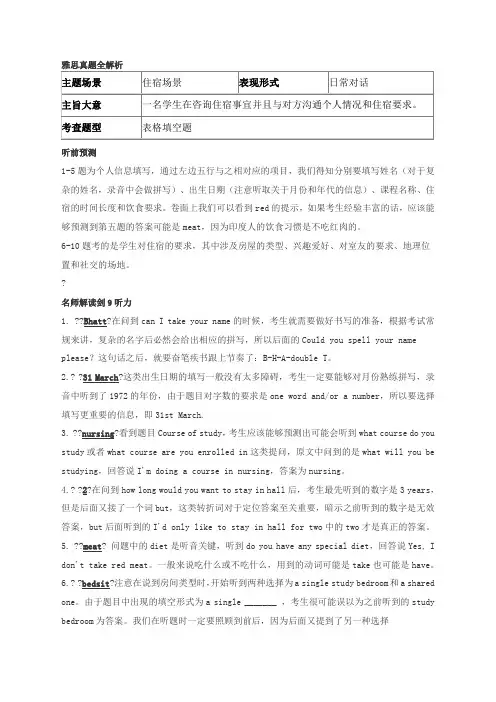
雅思真题全解析主题场景住宿场景表现形式日常对话主旨大意一名学生在咨询住宿事宜并且与对方沟通个人情况和住宿要求。
考查题型表格填空题听前预测1-5题为个人信息填写,通过左边五行与之相对应的项目,我们得知分别要填写姓名(对于复杂的姓名,录音中会做拼写)、出生日期(注意听取关于月份和年代的信息)、课程名称、住宿的时间长度和饮食要求。
卷面上我们可以看到red的提示,如果考生经验丰富的话,应该能够预测到第五题的答案可能是meat,因为印度人的饮食习惯是不吃红肉的。
6-10题考的是学生对住宿的要求,其中涉及房屋的类型、兴趣爱好、对室友的要求、地理位置和社交的场地。
?名师解读剑9听力1. ??Bhatt?在问到can I take your name的时候,考生就需要做好书写的准备,根据考试常规来讲,复杂的名字后必然会给出相应的拼写,所以后面的Could you spell your name please?这句话之后,就要奋笔疾书跟上节奏了:B-H-A-double T。
2.? ?31 March?这类出生日期的填写一般没有太多障碍,考生一定要能够对月份熟练拼写,录音中听到了1972的年份,由于题目对字数的要求是one word and/or a number,所以要选择填写更重要的信息,即31st March.3. ??nursing?看到题目Course of study,考生应该能够预测出可能会听到what course do you study或者what course are you enrolled in这类提问,原文中问到的是what will you be studying,回答说I'm doing a course in nursing,答案为nursing。
4.? ?2?在问到how long would you want to stay in hall后,考生最先听到的数字是3 years,但是后面又接了一个词but,这类转折词对于定位答案至关重要,暗示之前听到的数字是无效答案,but后面听到的I'd only like to stay in hall for two中的two才是真正的答案。
SECTION 1Questions 1-10Questions 1-5Complete the table below.Write ONE WORD AND/OR A NUMBER for each answer.Questions 6-10Complete the table below.Write ONE WORD AND/OR A NUMBER for each answer.雅思听力真题全解析听前预测1-5题是分类信息表格填空题。
考生应快速浏览表格的第一行和第一列,发现同一行是相关信息,同一列是同类信息,可以得知分别要填写的是公寓的名称、设施、相关信息和价格;接着,找出题目顺序,同时预测每个空格的答案词性,划出空格前后的定位词。
6-10题是分类信息表格填空题。
做题方法基本同上,不过,考生还应注意到:根据第一行的标题GREEKSLANDHOLIDAYS^知表格与度假有关;最后两行是附加信息,分别是姓名和电话雅思名师解读剑9听力1. 300 请注意,根据空格后的metres可知空格中应填数词,空格前后的salt-water swimming pool和beach是定位词。
此题直接给出了答案,没有陷讲。
2. Sun shade根据空格所在的这一列的另外几项可知空格中应填名词,且要大写首字母。
根据录音中女士说的there are just two more apartme nts 可知答案即将出现,接下来该女士磕磕巴巴地说sun ...Su nshine ,这其实是暗示考生答案更加接近了,但它同时又是陷阱,让考生以为Sunshine是答案,其实,女士的这句话只是提问,男士回答的the Sun shade Apartme nts 才是答案。
3. balco ny Greek pai ntin gs 是本题的并列成分,它既是定位词,又是定性词,决定空格中要填名词或动名词。
录音中,在Greek paintings 之后有个and,提示考生接下来给出的是其并列成分,即balcony。
本章我们为烤鸭们带来的是:剑桥雅思9Test2雅思听力Section3答案解析。
了解雅思1对1培训来雅思培训学校,突破高分只需十天!
SECTION 3
谈话场景:学业讨论场景
人物关系:老师和学生代表
谈话话题:老师和学生代表共同讨论Self-Access Centre的规划
剑桥雅思9Test2雅思听力Section3答案解析
交际与语言表达
1. 本段对话发生在老师和学生代表之间,讨论的是Self- Access Centre 的发展前景。
两个人见面Pam 就直入主题…As you know, I’ve asked you here today to discuss the future of our Self- Access Centre(你知道,我今天想和你讨论一下自主学习中心的发展前景),其中“as you know”表示“就你所知,你知道”之意,是固定搭配。
2. Jun 回答说Well, from the students’point of view, we would like to keep it(从学生的角度来看,我们应该保留它),“well”放在句首是语气词,一般不用翻译;“point of view”意为“观点,立场”。
3. The majority of students say that they enjoy using it because it provides a variation on the classroom routine and they see it as a pretty major component of their course…(大多数学生说喜欢使用它,因为它使课堂常规发生了变化,并且他们把它看作课程学习的重要组成部分),其中“the majority of”意为“……的大多数”,其后跟可数名词复数,谓语动词用复数;当作为一个整体看,其后跟单数名词。
该表达与a majority of 可以通用。
4. Pam 反对Jun 的观点,说Some of us also think that we could benefit a lot more by relocating the Self- Access Centre to the main University library building. 其中“benefit”在这里是动词,表示“受益”的意思;常用短语为“benefit from”,表示“因……而得到好处”;同时常见的“benefit”的名词用法,意为“利益,好处”;for the benefit of 表示“为……的利益”。
5. Jun 又说Well, the library is big enough to incorporate the Self- Access Centre, but it wouldn’t be like a class activity anymore(图书馆是大到足以包含自主学习中心,但它不再像一个课堂那样有互动了),“big enough”意为“足够大”,“anymore”意为“不再,再也不”,同义词组为“not any longer”。
此外,容易产生混淆的词组为“any more”,意为“再、还”,同义词组为“any longer”。
6. Well, there would still be a teacher present and he or she would guide the activities of the students…(还是应该有一个老师出席指导学生的活动……),“guide”这里做动词,意为“引导”,它还常作名词,意为“指南,向导”,如“tour guide”意为“导游人员”。
7. Is the cost going to be a problem?(费用将是一个问题吗?)其中,“cost”在这里用作名词,意为“费用,成本;代价”,常用短语“at the cost of”意为“以……为代价”。
8. Pam 有些顾虑:It’s not so much the expense that I”m worried about, and we’ve certainly got room to do it, but it’s the problem of timetabling a teacher to be in there outside class hours.“be worried about”意为“担心”,它是系动词+ 形容词表语+ 介词结构,系表结构侧重一种状态,这里表示担心的状态,和它同义的“be concerned about”则强调“关注、关心某事”。
9. Pam 说What about other resources?(其他资源如何?),这句话中的“what about”可以替换成“how about”,意为“如何”,“resources”意为“资源”。
10. Jun 又问What about if we agree to only use it before and after class?(如果我们同意只在课前课后用如何?),“what about”意为“怎么样”,中间省略了“is it”,完整句应该是“what is it about…”,常与“how about”相互
考题解析
Question 21 C 听前预测:定位词为keep、Self- Access Centre、because。
题目解析:快速浏览三个选项,找出核心区别点:A 选项为“喜欢各种设备”;B 选项为“喜欢自学”;C 选项为“学习的重要组成部分”。
仔细捕捉定位词,出题句为:…we would like to keep it…because it provides a variation on the classroom routine and they see it as a pretty major component of their course…(我们希望能保留自主学习中心……因为它使课堂常规发生了变化(即不再是以往的上课),学生把它看作课程学习的重要组成部分。
)所以正确答案为C。
另外,特别注意but 之后…we would like to see some improvements to the equipment…(我们希望设备有所完善……),借此排除A 选项。
Question 22 B 听前预测:定位词为some teachers、prefer。
题目解析:快速浏览三个选项,找出核心区别点:A 选项为“关闭”;B 选项为“搬走”;C 选项为“限制使用”。
本题干扰性不强,仔细捕捉定位词,出题句为:Some of us also think that we could benefit a lot more by relocating the Self- Access Centre to the main University library building,该句中“relocating”表示“迁移”,所以选项B 为正确答案。
Question 23 B 听前预测:定位词为main concern、using library。
题目解析:快速浏览三个选项,找出核心区别点:A 选项为“图书馆大小”;B 选项为“求助困难”;C 选项为“缺少资料”。
出题句为:…the library is big enough to incorporate the Self- Access Centre, but it wouldn’t be like a class activity anymore. Our main worry would be not being able to go to a teacher for advice. 本题定位较为容易,题干中concern 替换为worry,后面强调“无法得到老师的建议”,故选项B 为正确答案。
Question 24 C 听前预测:定位词为Director of Studies。
题目解析:快速浏览三个选项,找出核心区别点:A 选项为“升级成本”;B 选项为“缺少空间”;C 选项为“不容易监管”。
本题有一定难度,主要在于定位词不明显,根据It’s not so much the expense that I’m worried about, and we’ve certainly got room to do it, but it’s the problem of timetabling a teacher to be in there outside class hours 排除选项A 和B,特别注意否定词not,强调词certainly,故正确答案为C。